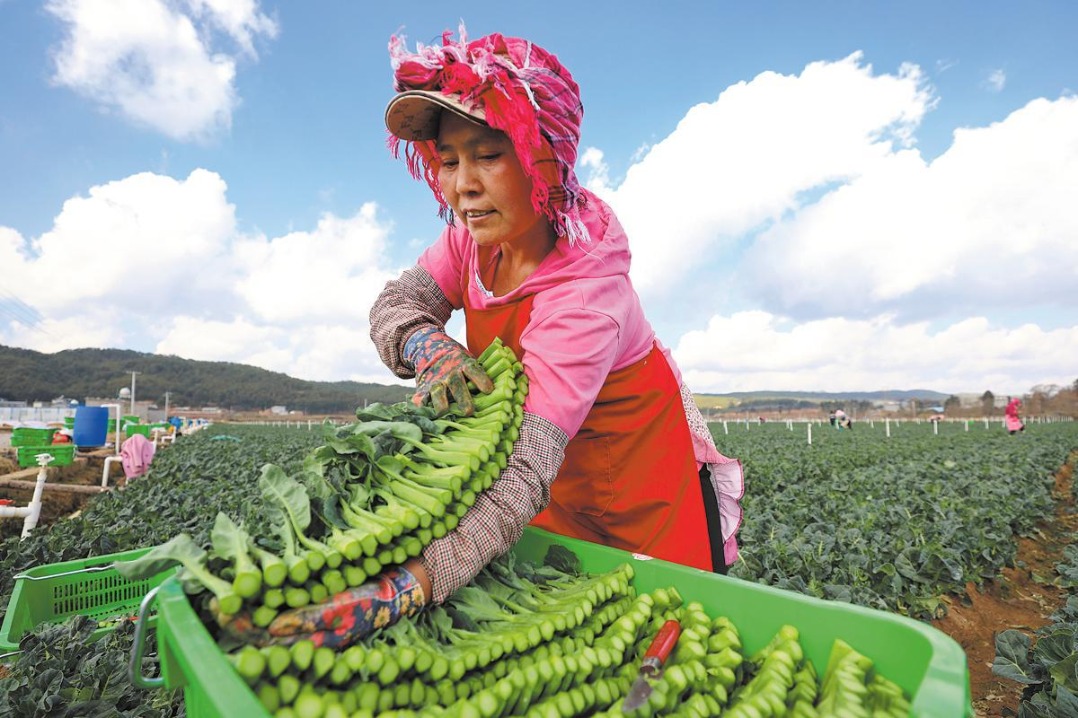A NATION OF FLAVORFUL TEA DRINKERS
Novel brews tickle consumer taste buds, and stimulate brands, investors, markets

For hundreds of years, Chinese drank freshly brewed tea without milk and sugar. That distinctive tradition is now history, in the sense that it is replaced by a modern culture where consumption of traditional tea is matched by increasingly popular tea bags and a variety of other imaginative products that consumers, especially the younger ones, find convenient, trendy and quality-rich.
COVID-19 that spawned a subculture of home-based work and education has also given rise to innovations in tea brewing and new flavors. And both the young consumers and investors are not complaining.
Unilever, a global food and beverage company, told Xiaoshidai, a new media outlet, its tea business has achieved double-digit growth in China. During the monthlong "618"online shopping festival around June 18, Unilever's e-commerce business grew more than 40 percent year-on-year.
Its tea brand Lipton offers more than 200 products in China, selling 2 billion cups of tea each year, in addition to its catering business that covers thousands of restaurants in the country.
Now, to make the most of the emerging opportunities in the tea business in China, Unilever will carve out large parts of its tea units, including brands like Lipton, Pure Leaf, T2, and Pukka, into a full-fledged tea subsidiary by the end of this year.
According to Nielsen's data, in 2019, Lipton had more than 70 percent of market share in non-herbal tea bags sector in offline channels.
Over the last few years, Unilever has been seeking more growth through the acquisition of other tea brands. In 2017, it bought out Tazo and British organic brand Pukka. Unilever has also rolled out new flavors, including white peach, oolong, grapefruit, jasmine and rosebud that are infused with healthy ingredients like ginseng and Chinese wolfberry.
With Lipton getting a refresh, other market entities, including startups, have jumped on the tea bandwagon. Domestic brands such as Chali and Lelecha have emerged, fueled by e-commerce that overcomes limits of geography and distribution channels. Local tea brands have become increasingly popular among youngsters by offering a range of flavors couched in rich images, purveyed by various marketing tools, said Zhu Danpeng, a food and beverage analyst.
"New flavors that make tea less bitter by mixing flowers and fruits as well as traditional Chinese medicine or TCM ingredients have given the traditional beverage a new boost. Meanwhile, innovative technology, including cold brewing and extractions that make tea quickly out of cold water, also helps boost the sales," said Zhu.
New tea brands have grown rapidly, and are now surpassing the sales of even traditional Chinese teas. Chali, a trendy tea manufacturer, sold nearly 600 million tea bags in 2020, mostly herbal and fruit varieties.
The brand, founded in 2013 in Guangzhou, Guangdong province, has completed two rounds of financing, with the first round attracting Guangdong Culture Industry Investment Management Company and Qianshu Capital led by the JD family and Yingxin Investment. On Sept 3, its second round saw investors such as Country Garden Venture Capital and CEC Capital.
The new fund will be used to expand its distribution channels and to establish a research and development center at Nansha in Guangzhou. Its Nansha factory is on track to complete its first phase project in October, with an investment of 80 million yuan.
Sun Zhiguo, vice-president of Chali, said:"The quality of tea as an agricultural product is easily affected by humidity and temperature. How to make taste and flavor with same standard depends on technology and research. Most of all, how to ensure tea brewed three times successively from the same bag tastes quite the same, is also important to make consumers return to the product again and again."
Most of Chali's consumers are aged between 18 and 35, and interested in healthy tea products. Chali's cube-shaped tea bags lock in or preserve the shape and flavor of tea leaves. The brand has invested heavily in e-commerce as well as brick-and-mortar retail channels like convenience stores and Hema Fresh supermarket, which are typically frequented more by young consumers, said Sun. The brand is expected to open no more than 100 stores for personal consumption and for gifting as well, he said.
According to Mintel, a market research provider, the total ready-to-drink or RTD tea and tea bags market in China in 2020 grew a modest 0.8 percent, compared to 2.4 percent in 2019. The COVID-19 pandemic slowed market growth, but only in the short term, with the impact of early restrictions on physical movement of people on sales neutralized by subsequent offline channel purchases and traditional consumption occasions.
The tea bag segment last year has benefited the most from the novel coronavirus outbreak, growing 81.1 percent in market value, according to Mintel's report released in May.
Increase in time spent at home created demand for tea drinking, attracting new players to the market. China's mature e-commerce enabled these new entrants to penetrate quickly into the market when consumers were more reliant on online shopping, said the Mintel report.
The tea bag segment is estimated to expand by a robust 28.8 percent compound annual growth rate in the 2015-20 period. Mintel forecasts the market will continue to grow at a substantial CAGR of 9.8 percent between 2020 and 2025.
In the foreseeable post-pandemic era, consumers will continue to look for stress-busters, mood enhancers, body-refreshing foods and beverages, all for moments of relaxation. In this context, tea bags' value proposition will likely prove unquestionable. More differentiation in functional benefits will also help the segment to fulfil increasing consumer demand for well-being, said Jenny Li, category director at Mintel China.
"The tradition of drinking tea freshly brewed from leaves remains dominant in daily consumption, but is experiencing a decline with more heavy users becoming light users."
There is a 12 percentage-point increase in the number of drinkers of instant tea varieties this year, driven by consumers with high personal income moving into the segment.
This means there is a genuine demand for convenient, quality tea drinks. Recent market innovations fulfil such consumer needs, according to Zhu Danpeng.
Although sales of tea drinks slowed in 2020, the negative impact of COVID-19 was short-term. Both RTD tea (non-Asian herbal teas) and tea bags have delivered strong growth, suggesting the market is worthy of more investor attention.
Functional benefits, especially those that cater to consumer demand for stress relief and beauty enhancements, are garnering strong consumer interest. Tea drinks' health appeal and association with relaxation give the category a competitive advantage in delivering value, segment experts said.
Arguably, tea drinks have fallen somewhat behind the curve in capturing new consumption trends and product innovation. The market has yet to see star startup brands as in other beverage markets, such as Genki Forest in sparkling drinks or Saturnbird in coffee.
Nevertheless, consumers are ready to embrace more premium products that can upgrade their tea drinking experience. This calls for brands to be bolder and active in their innovation, said the Mintel report.
"Tea drinks of different formats have experienced the pandemic differently, with the RTD segment facing challenges posed by limits on out-of-home consumption," said Li of Mintel.
"While tea infusions enjoyed an uplift thanks to the increased time spent at home, successful practices have been borrowed from the instant coffee market."

Today's Top News
- Xi addresses Central Urban Work Conference, listing priorities for urban development
- China reports 5.3% GDP growth in H1
- China handles 95 billion parcels in first half of year
- China, India vow to boost relationship
- Tips for expats to strike swifter friendships
- Digital initiative turns city into innovation hub






























